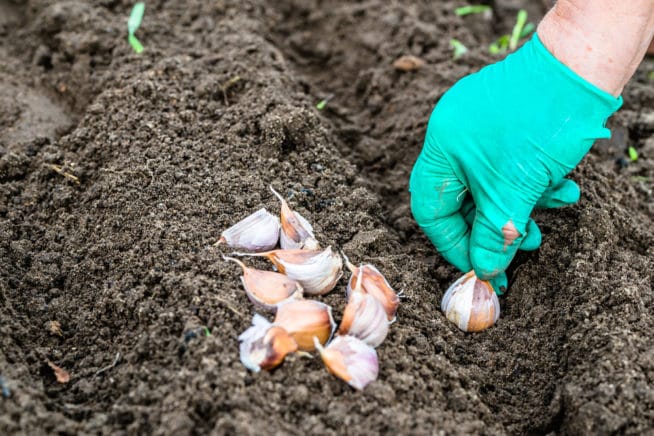Fall Garlic Planting Guide

A Step-by-Step Guide to Planting Garlic for a Bountiful Harvest

Garlic, the pungent and flavorful herb, is a staple in many kitchens around the world. But did you know that you can easily grow your own garlic at home? Fall is the perfect time to start planting, as garlic requires a period of cold dormancy to develop robust roots and form those juicy cloves.
Let’s delve into the process, covering everything from selecting the right garlic variety to harvesting and storing your homegrown garlic.
Selecting the Right Garlic Variety
Choosing the appropriate garlic variety is the first crucial step in your garlic-growing journey. Garlic comes in two main types: hardneck and softneck.
Hardneck Garlic: These varieties produce a flowering stalk called a ‘scape.’ They tend to have fewer, larger cloves and are generally hardier, making them a great choice for colder climates. Hardneck garlic also offers a more intense flavor and often has a longer storage life. Examples include Rocambole, Purple Stripe, and Porcelain varieties.
Softneck Garlic: Softneck varieties are more commonly found in grocery stores and are known for their longer shelf life. They don’t produce a flowering stalk, which means more energy goes into forming cloves. Softneck garlic is also easier to braid, making it a popular choice for decorative purposes. Some well-known softneck varieties include Artichoke and Silverskin.
Consider your local climate and your intended use for the garlic when making your selection.
Preparing the Soil and Site
Garlic thrives in well-drained, fertile soil with a pH between 6.0 and 7.0. Before planting, it’s crucial to prepare the soil.
- Soil Testing: Test your soil to determine its pH and nutrient levels. Garlic prefers slightly acidic to neutral soil, so you may need to adjust the pH with agricultural lime or sulfur.
- Fertilizing: Garlic is a heavy feeder, so add a balanced fertilizer or compost to the soil before planting. Aim for a nitrogen-rich fertilizer to encourage robust growth.
- Site Selection: Choose a spot with full sun, at least 6-8 hours of direct sunlight daily. Ensure the area has good air circulation to prevent diseases.
Planting Garlic
Now, it’s time to plant your garlic! Here’s a step-by-step guide:
- Clove Selection: Each garlic bulb consists of multiple cloves. Separate the cloves carefully, ensuring each clove has a good portion of the papery skin attached. Choose large, healthy cloves for planting, as they will produce larger bulbs.
- Planting Depth and Spacing: Plant cloves with the pointed end up and the flat end down. The depth should be about 2-3 times the length of the clove. Space the cloves about 6-8 inches apart in rows, with 12-18 inches between rows.
- Mulching: After planting, cover the cloves with a layer of organic mulch, such as straw or leaves. This helps retain moisture, suppress weeds, and provide insulation during winter.
Care and Maintenance
Proper care during the growing season is essential for a successful garlic harvest.
- Watering: Garlic requires consistent moisture, especially during the bulb formation stage. Aim for about 1 inch of water per week, either from rainfall or irrigation. Avoid overwatering, as garlic doesn’t like soggy conditions.
- Weed Control: Keep the garlic bed weed-free, as weeds can compete for nutrients and water. Regularly hand-pull weeds or use a shallow hoe to avoid disturbing garlic roots.
- Scape Management: If you’re growing hardneck garlic, you’ll need to decide whether to remove the scapes. While scapes can be a tasty treat, removing them early encourages larger bulbs. Snip off the scapes when they start to curl, but before they straighten out.
Harvesting and Storing Garlic
The wait is almost over! It’s time to harvest your garlic.
- Harvest Timing: Garlic is ready to harvest when the lower leaves start to turn brown and die back. This usually occurs in mid to late summer, about 9-10 months after planting.
- Harvesting Process: Gently lift the bulbs with a garden fork, being careful not to bruise them. Allow the bulbs to dry in a warm, well-ventilated area for a few days.
- Curing and Storage: After drying, trim the roots and cut back the stems to about 1 inch above the bulb. Store the garlic in a cool, dark, and well-ventilated place. Properly cured garlic can last for several months.
Troubleshooting Common Issues
Growing garlic is generally straightforward, but some issues may arise.
- Pest and Disease Control: Garlic is relatively pest-resistant, but keep an eye out for onion maggots and bulb mites. Rotating your crops and practicing good sanitation can help prevent diseases.
- Clove Rot: If cloves fail to sprout or rot soon after planting, it may be due to excessive moisture or poor drainage. Ensure your soil is well-drained, and avoid overwatering.
- Small Bulbs: Garlic bulbs may remain small if they are overcrowded or if the soil is nutrient-deficient. Space your plants appropriately and fertilize regularly.
Pro Tips for Garlic Growers
- Experiment with different garlic varieties to find the ones that thrive in your climate and suit your taste preferences.
- Intercrop garlic with other plants like lettuce, tomatoes, or strawberries to maximize your garden space and deter pests.
- Consider saving some of your largest, healthiest bulbs for replanting next season to ensure a continuous supply of homegrown garlic.

<div class="faq-container">
<div class="faq-item">
<div class="faq-question">
<h3>When is the best time to plant garlic in my region?</h3>
<span class="faq-toggle">+</span>
</div>
<div class="faq-answer">
<p>The ideal time to plant garlic varies depending on your location and climate. In general, garlic is planted in the fall, usually 4-8 weeks before the ground freezes. This gives the garlic time to establish roots before winter. However, in milder climates, you can plant garlic in early spring. Consult local gardening resources or extension services for precise timing in your area.</p>
</div>
</div>
<div class="faq-item">
<div class="faq-question">
<h3>Can I plant garlic cloves from the grocery store?</h3>
<span class="faq-toggle">+</span>
</div>
<div class="faq-answer">
<p>While you can try planting grocery store garlic, it's not recommended. Commercial garlic is often treated with growth inhibitors to prevent sprouting during storage. Additionally, the variety may not be suitable for your climate or growing conditions. It's best to purchase garlic specifically intended for planting from a reputable nursery or seed supplier.</p>
</div>
</div>
<div class="faq-item">
<div class="faq-question">
<h3>How much garlic can I expect to harvest from one clove?</h3>
<span class="faq-toggle">+</span>
</div>
<div class="faq-answer">
<p>On average, one garlic clove can produce a bulb containing 4-12 cloves, depending on the variety and growing conditions. With proper care and optimal conditions, you can expect a yield of about 10-20 times the weight of the original cloves planted.</p>
</div>
</div>
<div class="faq-item">
<div class="faq-question">
<h3>What should I do if my garlic bulbs split or have double bulbs?</h3>
<span class="faq-toggle">+</span>
</div>
<div class="faq-answer">
<p>Splitting or double bulbs can occur due to various reasons, including overwatering, excessive nitrogen, or unfavorable weather conditions. While these bulbs may not be as aesthetically pleasing, they are still edible and can be used in cooking. Simply separate the cloves and use them as you would regular garlic.</p>
</div>
</div>
<div class="faq-item">
<div class="faq-question">
<h3>Can I grow garlic in containers or raised beds?</h3>
<span class="faq-toggle">+</span>
</div>
<div class="faq-answer">
<p>Absolutely! Garlic can thrive in containers or raised beds, especially if you have limited garden space. Ensure the container or raised bed is at least 12 inches deep to accommodate the garlic's root development. Follow the same planting and care instructions as you would for in-ground garlic.</p>
</div>
</div>
</div>



